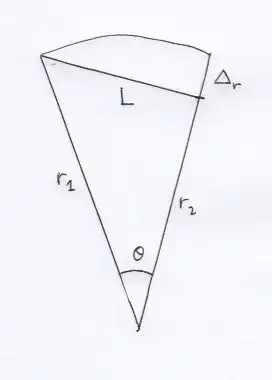I have to place a series of line segments along an $r=k\theta$ spiral. All the line segments are the same length (which I will call $L$) and the starting point of each is the finish point of the previous.
For my task I decided it will be easiest to do if I can determine the next radius $r_2$ from the previous radius $r_1$ (or the angle $\theta$ from the previous radius $r_1$).
So, I have the equations:
$r_2 = r_1 - \Delta r$
$\Delta r = k \theta$
and of course all the triangle relations from $\theta$ being between $r_1$ and $r_2$ and opposite $L$.
I plugged them together to get $r_1-k \theta=r_1\cos(\theta)\pm\sqrt{L^2-r_1^2\sin^2(\theta)}$
So, I need to solve for $\theta$ to get my $\theta$ and $r_2$. But, I don't know how to do this and the online solvers can't manage it (although they can solve very close ones...) Can anyone help with it?
Thank you!
